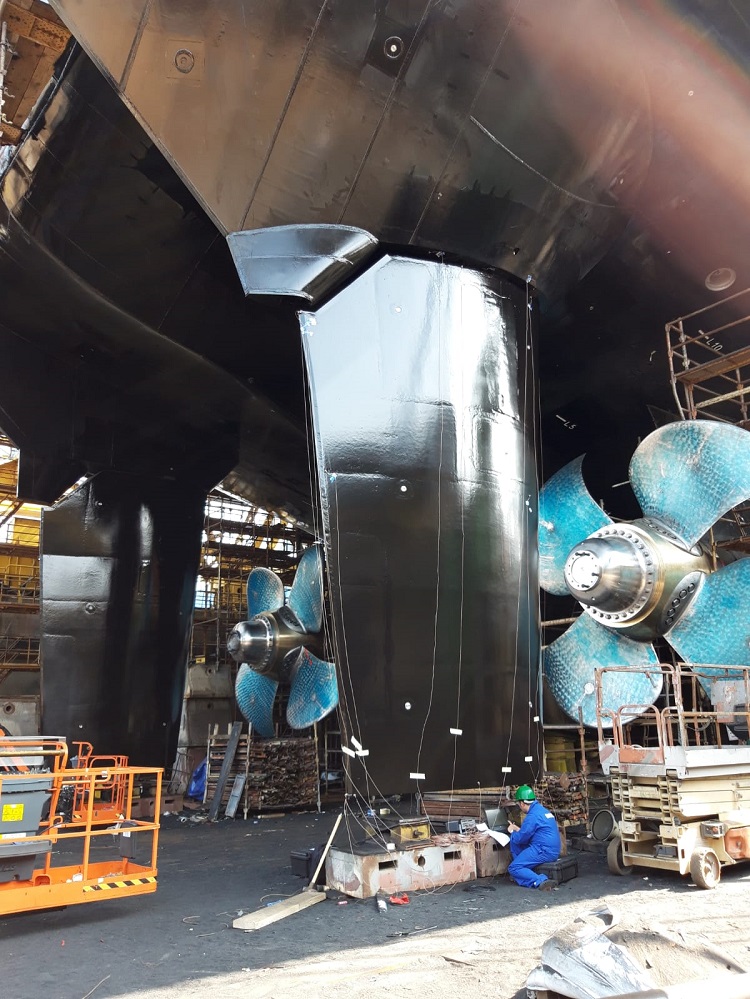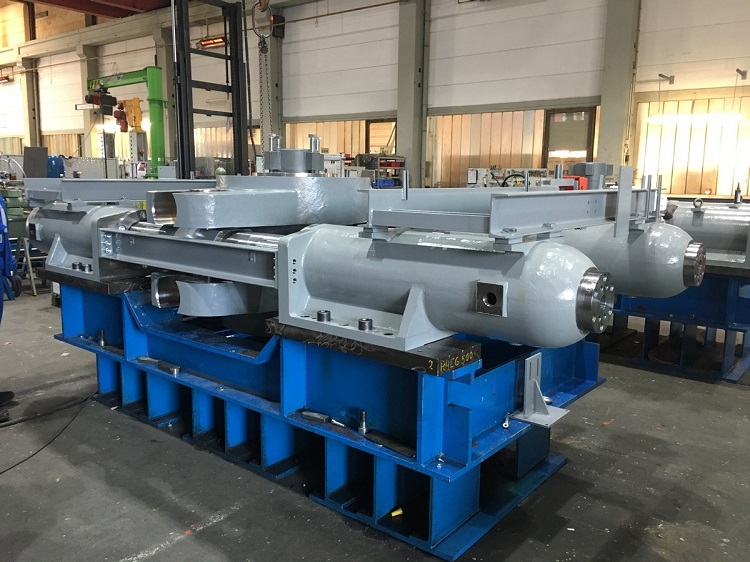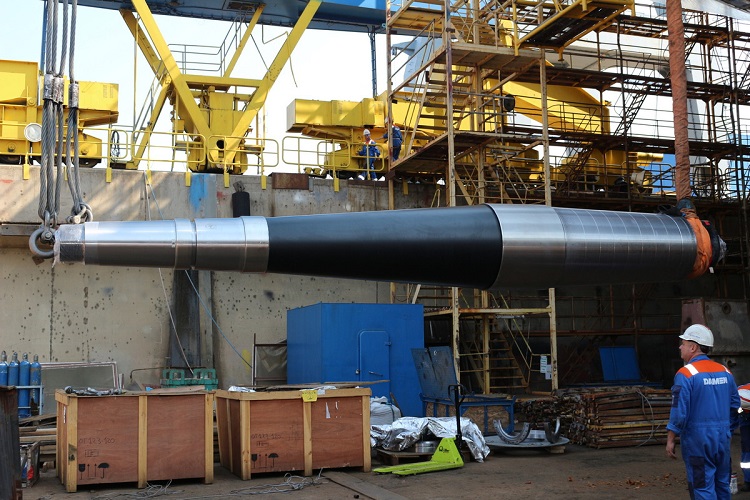New Australian Icebreaker Receives Unique Steering System
The Antarctic Supply Research Vessel Nuyina being built for the Australian government’s Antarctic Division has been supplied with unique rudders and steering gear.
The rudders have been designed and engineered by project-lead Damen Schelde Naval Shipbuilding (DSNS) as free-hanging, full-spade rudders. These deliver optimum hydrodynamic properties but until now were unheard-of for an icebreaking vessel of this class given the forces involved. Other innovative features include the integrated mechanical rudder stoppers, which are located between the rudder blade and (hull) skeg structure rather than on the outside hull due to the latter’s radical design.
Damen Marine Components (DMC) completed the supply and installation of a number of critical systems. These had to be fabricated to exceptionally high standards to cope with the ice that the vessel will encounter in the Southern Ocean. DMC, under its Van der Velden Marine Systems brand, is responsible for the detail engineering and manufacturing of the rudder and steering gear system.

Full-Spade Rudders by DMC

RAM Type Steering Gear Assembly by Macgregor Hatlapa
.jpg)
Skeg

Rudder Stock by Van der Velden Marine Systems
To deliver all the necessary steering system components from the bridge to the rudder, including hydraulics, control and power systems, while meeting the unprecedented performance requirements, DMC pooled its expertise in this field with that of MacGregor Hatlapa. Working to DMC’s specifications, MacGregor manufactured and supplied the steering gear assemblies and the hydraulic systems that power them based on a highly-customized version of its proven Poseidon series. DMC delivered the rudder system, neck and carrier bearing systems steering gear foundations, electrical system, and the primary steering control system.
With so many of the systems breaking the boundaries of normal icebreaker design and build, DMC worked closely with Lloyds Register’s polar division throughout the process to ensure that the required standards were established and achieved. The results of this cooperation include rudders that are by far the heaviest per square meter that DMC has ever built and rudder stocks with a diameter of over a 1,000mm. This together with the materials used made them very challenging to manufacture and install.
These high specification components are vital to the safe and reliable operation of the vessel. Her combination of icebreaker classification and high polar class notation creates the need to enhance her structural integrity such that, while the maximum design speed of the vessel is actually around 16 knots, most of the components have had to be designed to cope with theoretical speeds in excess of 31 knots.
This joint-venture approach was chosen due to DSNS requiring proven technology and a single supplier, yet the specifications were such that no standard products available from DMC and its leading competitors came close to being able to withstand the expected forces.
While being only 160 meters (526 feet) in length, the stresses imposed on the hull and its components are equivalent to those found on a normal vessel of 300 meters (984 feet) or more.
The Nuyina is being built at Damen Shipyards Galati and is due to be delivered in April 2020.
The Nuyina
The RSV Nuyina is the main lifeline to Australia’s Antarctic and sub-Antarctic stations and the central platform of our Antarctic and Southern Ocean scientific research. It is faster, larger, stronger and offers increased endurance compared with Australia's existing vessel, the Aurora Australis.
The Nuyina will provide a state of the art platform to conduct multidisciplinary science, both in sea ice and open water. It will also deliver personnel, cargo and equipment to and from Antarctic and sub-Antarctic stations. The icebreaker will be able to handle:
• waves up to sea state 9 (14 meters (46 feet) plus significant wave height)
• wind speed up to Beaufort 12 (hurricane)
• air temperature ranging from −30° Celsius to 45° Celsius, and
• water temperatures ranging from −2° Celsius to 32° Celsius.
She will have the capability to:
• travel at an efficient cruising speed of 12 knots, with a maximum sustained speed of 16 knots in open water
• break ice at a continuous three knots in ice of 1.65-meter (5.4-foot) thickness
• transfer personnel and cargo from the icebreaker to the stations using a range of means over water, over ice and by air, including the capability to operate and support four light helicopters or two medium helicopters
• handle, stow and transport up to 1,200 tonnes of solid cargo consisting primarily of containers and break bulk cargo, including large items of plant and equipment using the ships own cargo cranes, and
1,900,000 liters of bulk liquid cargo (Special Antarctic Blend diesel used for station operations)
• support voyages for up to 90 days, which includes the ability to remain within the Antarctic area for up to 80 days
• accommodate 117 personnel with modern services including a specialised medical facility, and
ensure a high standard of environmental compliance.
The vessel will be able to sustain multidisciplinary and concurrent science operations, and support numerous sample and data collection systems, including for sea-floor, sea-ice, sea life and atmospheric research. It will have the capability to deploy, operate and with location precision recover a range of equipment and instruments in a range of conditions including:
• drop keels and a moon pool to support a wide range of scientific research operations and modes
• a multi-beam bathymetric echo sounder for mapping the sea floor at full ocean depth
• sub-bottom profiler to analyze the physical properties of the sea floor
• scientific echo-sounders for biomass assessment and fisheries sonar systems, and
• hydrophones and underwater cameras.
She will have a dynamic range of fixed and portable work spaces, facilities and services to support experimentation and analysis and the capability to deploy a specialized marine tender.
Length overall: 160.3 meters (526 feet)
Maximum beam: 25.6 meters
Maximum draft: 9.3 meters
Displacement: 25,500 tonnes
Icebreaking: 1.65 meters at three knots
Speed: 12 knots economical, 16+ knots maximum
Range: > 16,000 nautical miles
Endurance: 90 days
Cargo fuel capacity: 1,900,000 liters / 1,671 tonnes
Container capacity: 96TEU
Cargo weight: 1,200 tonnes
Passengers: 117
Crew: 32
